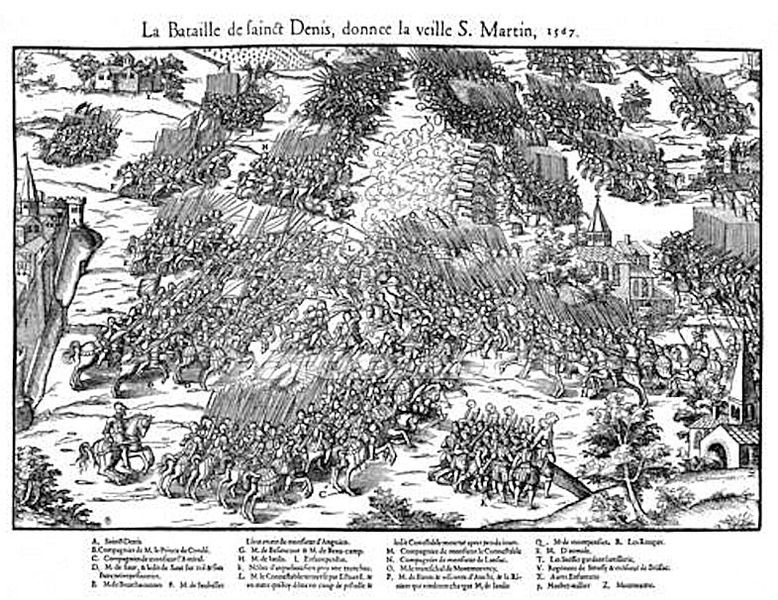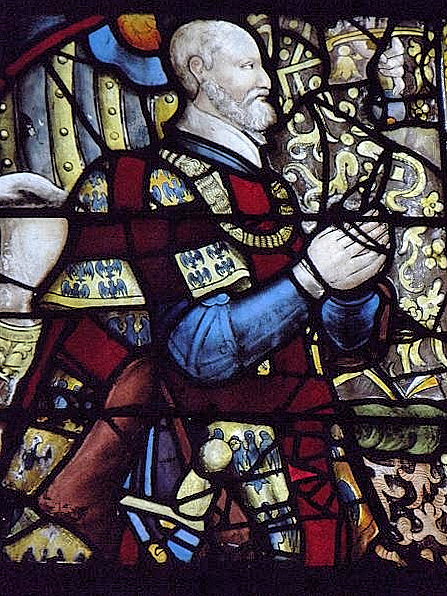Anne de Montmorency 1493-1567 Constable of France, Canvas painting by Dominique Henri Guifard, located in Musée Condé, Chantilly, France.
Anne de Montmorency had proven many times before that his race does not degenerate and the brave blood of an illustrious line of ancestors flowed in his veins. Imperious, severe, of a stern mood, he had undeniable bravery and strict fidelity to his duty. Although success had not always been on a par with his loyal intentions and he was defeated at the Battle of Saint-Quentin, his eminent services to the Crown won him top honors that manifested the esteem in which Francis I and Henry II of France held him. He became grand master, Constable of France in 1538, duke and Peer of France in 1551. Never has anyone more worthily held the sword of Constable.
Battle of St Denis, November 10, 1567
The glorious fashion in which he died is worth recounting. We are in 1567; the Calvinists have taken up arms again under the leadership of Louis de Bourbon, Prince de Condé. Montmorency defeats them on November 10 at the Battle of Saint-Denis; but towards the end of the action the troops under his command, seized with panic, disband and flee. Leading a few brave soldiers the valiant Constable, rash but heroic, tries to stop the enemy and wash away the shame which covers his men. Wounded six times, dismounted, worn out, he fights on regardless. His sword breaks on penetrating a chink in the armor of a Calvinist. That is when a Scottish gentleman named Robert Stuart[1] summons him to surrender. “Me surrender! You don’t know me,” Montmorency replied. “This is because I do know you,” Stuart replies, firing a pistol into his kidneys.
Though mortally wounded, he still had enough strength to badly bruise the face of the Scotsman with a furious blow of his sword hilt, still held firmly in his hand. The two enemies rolled together on the ground. As he came to, Montmorency asked how the battle was developing and learned that it had been won. He then ordered the news of the victory be confirmed. “My cousin,” said he to René de Sanzay, I am a dead man; but I thank God that I am dying for my religion, my King and my country.” Longing to die on the battlefield, he would not allow himself to be carried off. But he finally gave in to the general entreaties: “I consent,” he said, “not because I still hope to heal, as I am a dead man; but in order to see the King and Queen again to bid them farewell and display, with my wounds, the pledge of the loyalty I always had in their service.” Two days later, the head of the Catholic army dies in his house at Rue Saint-Avoye, at age 74, having served in the military from childhood and mightily contributed to the glory of the French armies.
Stained glass window of Anne de Montmorency in Saint-Acceul (Écouen)
Viscount of Noailles, La Mère du Grand Condé (Paris: Emile-Paul Frères, Editeurs, 1924), pp. 2-3. (Nobility.org translation)
Short Stories on Honor, Chivalry, and the World of Nobility—no. 125
[1] This Scotsman probably had no relationship with the Royal House of Stuart; he is believed to have belonged to the Scottish clan by that name. He was later imprisoned and executed for having killed Montmorency.





No comments:
Post a Comment